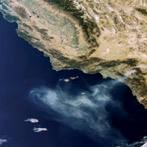
Fires, source of CO2
- According to researchers at the University of Colorado’s NCAR, major fires in the U.S. emit as much carbon dioxide as all vehicles in the U.S. year round.
Joxerra Aizpurua Sarasola
2007ko abenduaren 04a

Kaliforniako sutea
This claim has been made using satellite photographs and a computer model that estimates the amount of carbon dioxide emitted by the fires. The authors assume that there is a margin of error of 50%.
Analyzing the fires in a dozen states, they found that they emitted carbon dioxide very quickly. As an example, the fire that occurred in Southern California from October 19 to 26 has been used. This resulted in 7.9 million tons of carbon dioxide emissions, which is a quarter of California’s monthly emissions from fossil fuel combustion. The fact that the gas is emitted so quickly makes it very difficult to understand the carbon cycle. As a result, there may be difficulties in coping with the greenhouse effect.
When an area burns, new vegetation forms, but can it recycle the emitted carbon dioxide? How Much Can You Recycle: Less or More Than Roasting? The answer is difficult to give, and often as soon as new vegetation forms, it burns again. Too many questions still unanswered.
Several French and German researchers have reported in the journal Nature of a unique underground movement that occurred under the sea in Africa. In this movement, which has taken place in front of the Moroccan city of Agadir, 2,250 billion kilograms of sediment have been displaced, ten times more than what the rivers bring to the seas each year. The sediments appear to have travelled a distance of 1,500 kilometres, from Paris to Rome, and have accumulated in a place where the seabed was rising.
It should be noted that the study has been partly funded by Exxon Mobil and Shell. It’s not surprising, as underwater facilities for the exploitation of hydrocarbons are being added, so what happens on the seabed is becoming increasingly important for these companies.
Analyzing the fires in a dozen states, they found that they emitted carbon dioxide very quickly. As an example, the fire that occurred in Southern California from October 19 to 26 has been used. This resulted in 7.9 million tons of carbon dioxide emissions, which is a quarter of California’s monthly emissions from fossil fuel combustion. The fact that the gas is emitted so quickly makes it very difficult to understand the carbon cycle. As a result, there may be difficulties in coping with the greenhouse effect.
When an area burns, new vegetation forms, but can it recycle the emitted carbon dioxide? How Much Can You Recycle: Less or More Than Roasting? The answer is difficult to give, and often as soon as new vegetation forms, it burns again. Too many questions still unanswered.
Thousands of tons of earth dancing under the sea
Several French and German researchers have reported in the journal Nature of a unique underground movement that occurred under the sea in Africa. In this movement, which has taken place in front of the Moroccan city of Agadir, 2,250 billion kilograms of sediment have been displaced, ten times more than what the rivers bring to the seas each year. The sediments appear to have travelled a distance of 1,500 kilometres, from Paris to Rome, and have accumulated in a place where the seabed was rising.
It should be noted that the study has been partly funded by Exxon Mobil and Shell. It’s not surprising, as underwater facilities for the exploitation of hydrocarbons are being added, so what happens on the seabed is becoming increasingly important for these companies.